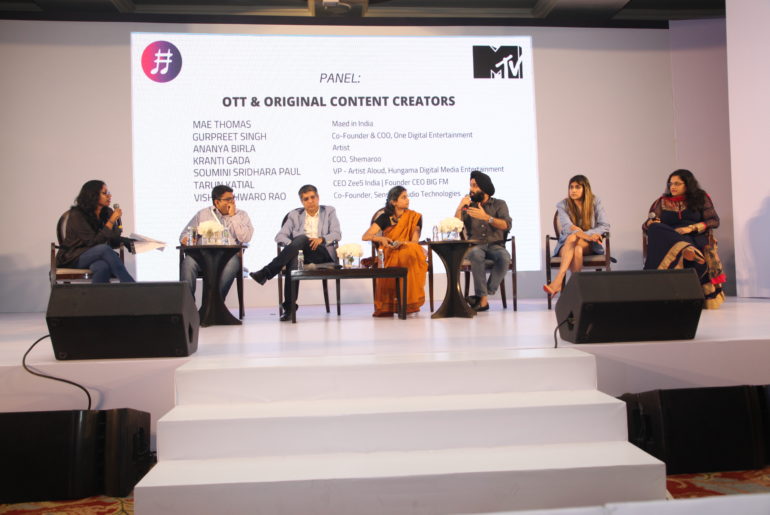The rapid growth of innovations in the Indian music industry are at an all time high. Where is it headed? Where will it take the industry? Music Inc., a two-day long conference presented by MTV India and curated by Loudest.in and exchange4media, recently had an introspective panel discussion on the implications of marketing and innovations in the industry to find answers.
The discussion had a panel of esteemed industry leaders like
Samir Singh Shekhawat (CMO - United Brewries); Kiran D’Cruz (National Head – Sony Music Entertainment India); Clinton Cerejo (Music Director, Composer & Singer) and Panshul Jhingan (Chief Strategy & Revenue – One Digital Entertainment).
Validation from the pre-eminent Bollywood a must to reach scale?
Commencing with the topic of dominancy of Bollywood music in the industry, Shekhawat questioned if the pattern is changing with the influx of new and qualitative independent music. On being asked if new music must require Bollywood's stamp of approval to reach scale, Kiran clarified that
Bollywood is not a genre; It is a platform, a reflection of the current state of mind of the Indian audience. Bollywood stands for 'the flavor of the season'.
He explained that if rock, as a genre, is popular amongst the Indian audience, Bollywood takes it, enhances it, amplifies it and comes out with of a bunch of rock songs. Having said that, he elucidated the importance of digital platforms like YouTube stating that
artists are not just musicians anymore, they are a brand of their own.
Is commercialization of music killing creativity?
Taking into consideration the various platforms on which artists are blasting off their singles (solo tracks), Samir asked Cerejo if creativity is being sacrificed at the hands of commercialization.
Cerejo pointed out his personal observation that one of the
biggest losses to Bollywood (in his opinion) has been the over-engagement of several music directors for one film.
A movie director will not hire several DOP’s (Director of Photography) to shoot different scenes of a movie, but it is happening to music directors. Ideally, one music director should be hired for one movie to give the story a cohesive feel. Songs in movies are being used as promotional tools to add to the profit of the opening weekend which is in fact reflecting on the quality of art.
Evolving relationship between Music and Brands
Panshul, who comes from a dynamic yet traditional industry of advertising had a few insights into the placement of songs in a context and how they are/are not in accordance with a story.
Jhingan explained how brands used to look as creative directors as minds and the artists as a face of the creative. But this kind of approach is slowly changing as
artists understand the perspective of fans and how the synergy of the content can influence consumers of the brand. He labeled the art of composition as
‘magical’ giving an example of his work with ESPN in 2008. He stated that he was left astonished when they got A.R. Rahman on board for the campaign. He could not believe that
An artist through music can drive an entire conversation for a brand.
Citing another instance of his work with Nokia, he aimed to recreate the nostalgia by getting Ehsaan, Loy and a couple of independent artists like Shirley Setia, Darshan, DJ Chetas together for its rendition. He concluded that musical content and creative should do the talking and brands have come to understand the cause behind it.
https://www.youtube.com/watch?v=EfYWh4bMMPg
Independent music struggling to reach global markets?
Shekhawat pressed on the struggle indie musicians face to make a name for themselves in the Indian market let alone compete on an international level. However, there was a
cohesive wave of optimism amongst the three speakers.
Signifying the rise of digital stars, Kiran disagreed with the statement completely.
The rise in free streaming platforms is enabling artists to put out music. Record labels can enhance and market independent music better but artists don’t need labels anymore.", he said.
Cerejo gave the example of BTS, a Korean Pop Band, which topped the charts in the United States. He stated that language is no barrier and Indian artists should stay as current as they can as musicians.
Are music innovations creating a convoluted environment?
Paid applications (Apple Music; Amazon Prime Music), free applications (Saavn; Gaana), discovery platforms (Smule; Shazam) as well as the prevailing superlatives like YouTube, SoundCloud, Spotify are exploding content. With a plethora of platforms to discover content, Shekhawat asked the panel if the ecosystem is getting too complex.
While Kiran said that record labels act like a funnel, Cerejo had an insightful idea. As a musician, he laments the replacement of CD’s as the behind-the-scenes musicians are not discoverable in the digital world.
Earlier, I’d check the CD and would know who has played what in the liner notes. The innovation of credits has not evolved. It has devolved. Why is it so hard for the big boys to create a system for credits. If this happens, you’ll see art going back to what it’s really about – genuine music.
Concluding the discussion, Shekhawat had one last question directed towards Panshul –
Where is the money in music today since every service is almost free. Panshul assured there is money and platforms like YouTube and new apps are providing royalties to artists based on fan followings. All in all, the industry is in a transitory yet lucrative phase.

